Remote work is about to blow up even more in 2024, and you’ll have to prepare. The typical 9-to-5s are evolving super fast and going virtual—which means remote team management challenges are also evolving.
Since people can now work from different places and in different time zones, new problems are coming to give you a hard time. Now, the question is: What can you do about it to catch up? In this article, we’ll:
- Identify some of the most common challenges in managing remote teams
- Take a peek at recent trends and statistics in the remote team management landscape
- Discuss the freshest ways to overcome remote team management challenges like an absolute champ in 2024!
“Nice-to-Know” Remote Team Statistics and Trends You Should Watch Out For In 2024
It hurts no one to know a fact or two about the latest trends in the industry. See below some nice-to-know data and trends from the past few months or years. This is useful information that you can use for your next remote team management strategy.
So let's look at some remote work statistics you shouldn't ignore.
1. In 2023, 12.7% of full-time employees worked from home, while 28.2% worked a hybrid model
Source: Home Choice

Remote work arrangements may offer employees certain benefits that they won’t get from working onsite, like:
- Potential higher income
- Work flexibility, and
- Work-life balance; but at what cost?
Even with all the benefits mentioned, remote work options still pose similar challenges to onsite setup like burnout, mental health issues, feelings of isolation, and a terrible time building and maintaining real-world relationships.
This is when the hybrid work model setup comes in. Offering benefits from both onsite and remote work. In a nutshell, the hybrid work model provides the best of both worlds for remote work employees.
2. 30% of respondents told researchers they were more productive and engaged working from home
Source: Apollo Technical
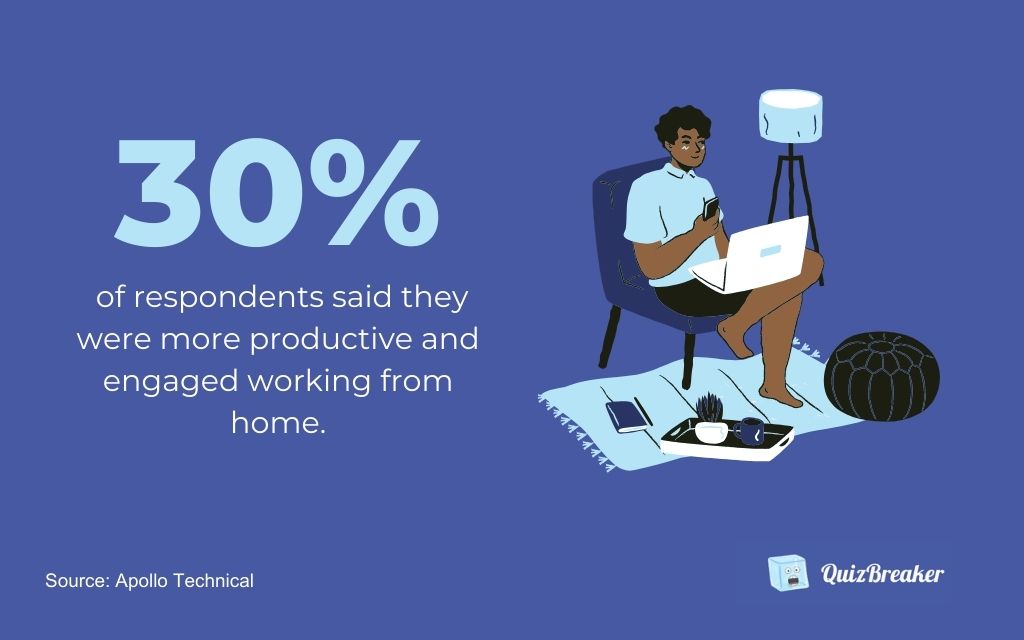
Working remotely has its benefits that include more productivity and work engagement. But this isn’t always the case, especially for the majority of the respondents, which was 70%.
Where do you draw the line between work and life when working from home? This data is based on the survey carried out by The Becker-Friedman Institute for Economics at the University of Chicago.
3. 44% of companies do not allow remote work of any kind
Source: Linkedin.com
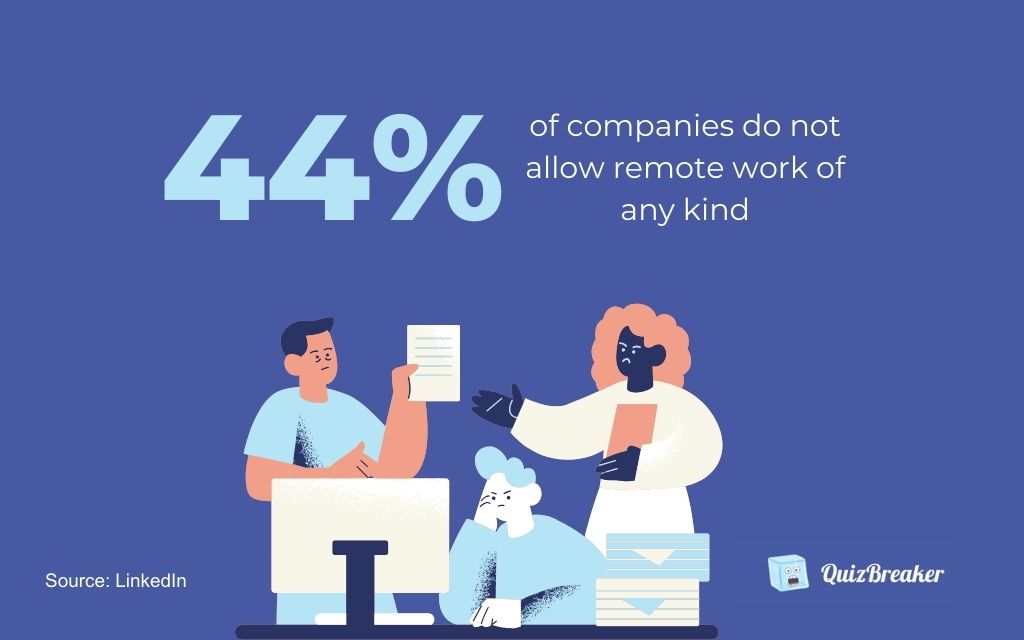
A large percentage of companies all over the world are still hesitant to engage and embrace remote work policies of any kind due to rooted concerns surrounding employee productivity, collaboration, employee engagement, data breaches, and maintaining company culture.
Take note: Some industries like healthcare, fire departments, construction, agriculture, supermarkets, and salons cannot operate remotely. Thus, requiring employees to work one hundred percent onsite.
4. Remote employees save up to 72 minutes daily from commuting
Source: Squaretalk.com
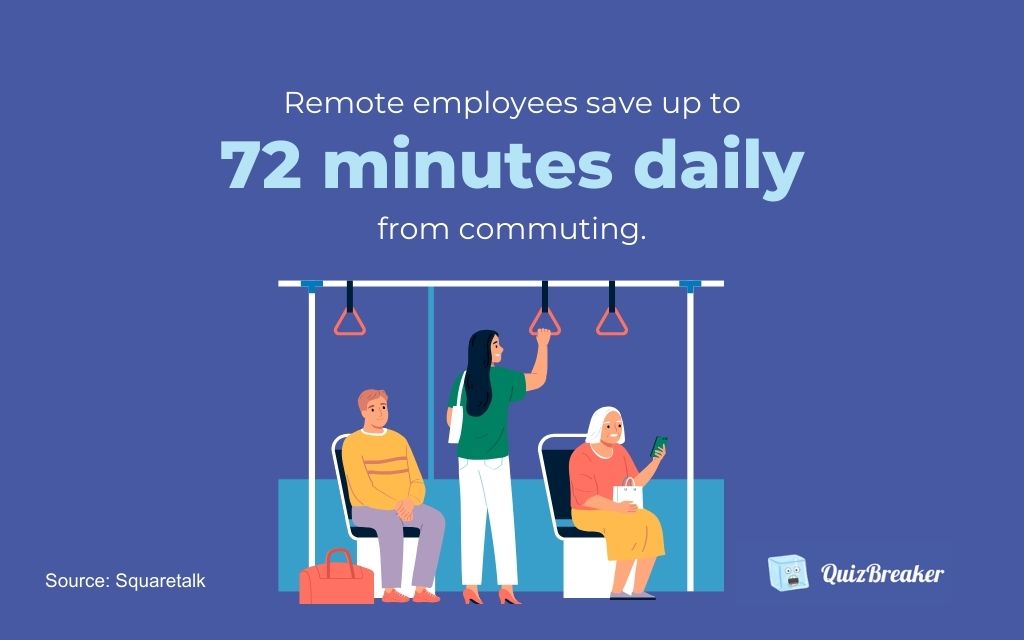
The average time saved with remote work environments can range from 40 to 72 minutes per day commuting in 2021 until 2023. Since there’s time saved, workers take advantage of these extra hours to get more sleep and do activities other than work, improving their career, health, and well-being.
5. 98% of workers want to work remotely at least some of the time
Source: Hubspot.com
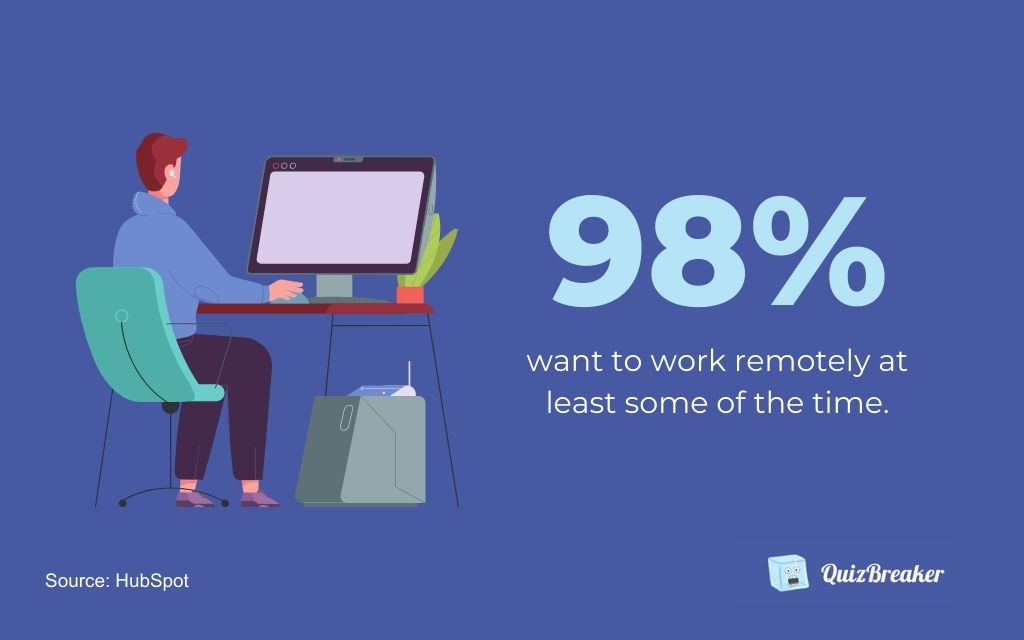
Working anywhere on your preferred hours is the absolute flex nowadays.
It’s what makes up most of the appeal of remote work for many. A huge portion of the global workforce (87%) says they will embrace flexible work arrangements and remote work setups when given the chance. Shockingly, Buffer's study shows a mindblowing 98% of respondents desire to experience remote work in their career.
6. The top benefit of remote work in 2023 was flexibility in how respondents can spend their time (22%)
Source: Buffer
.jpg)
Time and location freedom while you work is one of the main benefits of working remotely. Buffer says 33% of remote workers from their research sample are constantly stuck at home due to a lack of reason to leave.
Working on-site is considered a “good excuse” for some to leave the house daily or regularly to avoid locking themselves at home. Sadly, isolation, burnout, and depression are some of the downsides of remote work, just to name a few.
7. In 2023, nearly a third of respondents desired 5 days of work from home per week (30%)
Source: Linkedin
.jpg)
Primarily due to the upsides and the benefits of working remotely. Remote work usually offers higher income, savings, and flexible work hours plus location freedom.
8. Despite the growth in remote work, office space occupancy in the U.S. surpassed 50% in September 2023, with the peak day of office occupancy reaching 60%
Source: Techopedia.com
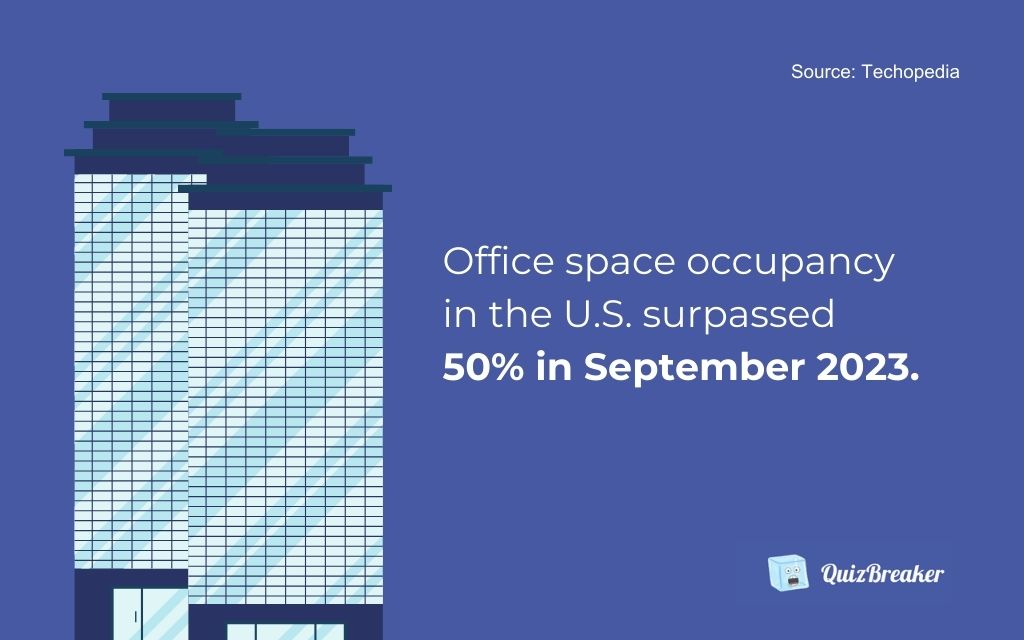
Experts state that growth in remote work may or may not be a good thing for businesses, but figures from the predictions imply that the current volume of return-to-office employees is less likely to rise further since remote and hybrid work models are slowly becoming the norm for white-collar workers from certain industries, especially in tech and digital marketing. Not to mention, satisfied remote workers are less likely to return to onsite job positions at this point, even if allowed to earn more since they’re enjoying the freedom and flexibility that only remote work can give.
9. In September 2023, 28% of workdays were worked remotely, a significant increase from 7% in 2019
Source: Techopedia.com
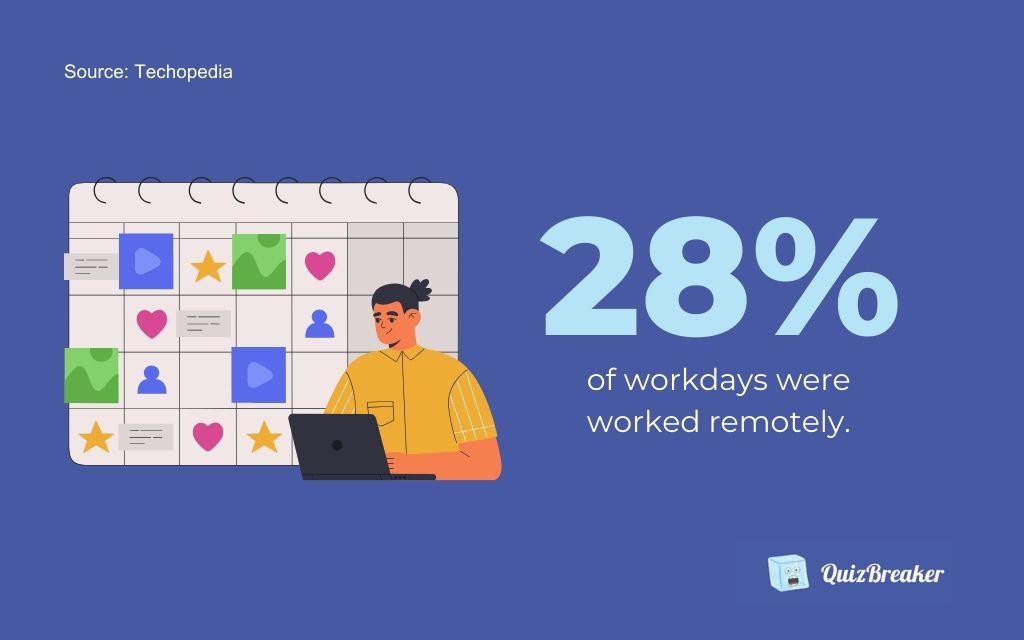
The COVID-19 pandemic blew up the need for employees to work from home. It started at 5% in 2019 and is now at 25% (a 500% increase). But even in recent years as the pandemic died down, people still sought a remote work experience.
We can expect more people to be interested in remote jobs in the next few years. More advancements and technological changes are on the way to make remote work more accessible to the general public—pushing the barriers of entry much lower.
10. 65% report wanting to work remotely all of the time
Source: Novoresume.com
.jpg)
The convenience of working remotely, tied with other benefits like time flexibility and financial savings, makes this work setup most popular.
Meanwhile, 32% of surveyed employees prefer a hybrid setup where they can have the flexibility of remote work and still have the option to work in a workplace where they can collaborate with their coworkers in an office.
Top Industries and Jobs for Remote Workers

These are the top industries and jobs remote workers should check out this year (coming from two different sources):
Forbes Advisor listed industries and jobs that have a growing number of remote employees in 2024, with computer and IT ranked as the number one.
- Computer and IT
- Marketing
- Accounting and Finance
- Project Management
- Medical and Health
- HR and Recruiting
- Customer Service
On the other hand, according to an article posted by Outsource Accelerator. This is their take on the Top 10 Remote Jobs and Industries in 2024:
- Customer service staff
- Telemarketing
- Virtual assistance
- Web development
- Software development
- Digital marketing
- Graphic design
- Project management
- Accounting
- Human resources
10 Best Practices When Managing Remote Teams

What we’re all here for. These are the best practices for managing remote teams:
1. Establish a solid remote work structure
Do you follow a system when managing your remote team? A solid work structure for your team makes things less complicated for the team and yourself. Making your goals measurable and easier to achieve.
One example of establishing a solid structure is by developing standard operating procedures (SOP) and setting a fixed or rotating schedule for meetings and deadlines for your team to follow. This is ultimately vital for remote work where communication is often minimal or deprived. An effective work structure should help you maintain output quality and achieve your desired outcomes. You can also optimize your onboarding and employee training procedures.
Keep a close eye on your strategy and constantly look for ways you can improve the onboarding process to minimize errors while boosting productivity, and employee engagement, and lessen employee turnover.
2. Continuously improve the communication channels
How do you reach out to your team members? This isn’t the 60s. You don’t have to rely on just emails if you want to chat briefly with your team members. Try instant messaging apps and social media.
Nowadays, there are endless options that you can use to reach anyone at any time, such as Facebook Messenger, WhatsApp, Microsoft Teams, Pumble, Slack, iMessage, and more.
Regular video or voice-only conferences are also useful for discussing and setting your team’s weekly goals and priorities.
Making sure you choose the appropriate messaging platform is very important since most platforms offer different yet similar functions with varying limitations, like media sharing, syncing, and add-on plugins.
Pros of using tech-based communication tools:
- Accessible to everyone
- Comprehensive
- Instant
Aside from it being dependent on the speed of your internet, the downside to tech-based communication tools is they take some time to get used to. It can take a while, but it typically varies for everyone.
3. Check-in with your remote team members regularly
How well do you know about their role, the team members, and their work ethics? Working remotely requires extra effort, especially in the communications department.
That’s why regular check-ins are considered a game-changing factor if you want to successfully understand your employees, their roles, workload, and all the moving parts of your business. This way, you know exactly how to provide support where needed.
For regular check-ins, simply schedule a 1:1 call or by-group conference, depending on the interview type you wish to conduct.
Regular check-ins are typically conducted:
- To make employee well-being and progress tracking easier
- To help address technical issues
- To maintain and/or boost employee engagement
- To check for means to minimize employee turnover
4. Documented procedures thoroughly
Keeping a thoroughly written record of procedures done by your team to accomplish a specific output lessens the need for communication—as long as these records are accessible to your team via cloud storage.
This detailed record ensures that everyone stays informed and minimizes the chances of you having to repeat yourself over and over again. A well-prepared documentation also helps your team maintain consistency in distributing and completing tasks and projects. As you know, it’s hard to manage a team—especially a remote team that you rarely or will never meet in person.
5. Be receptive to member feedback and suggestions
Don’t be afraid to involve your team members in decision-making and creating a safe environment for their input.
Receiving feedback and suggestions from your employees has many benefits to you and them. When worker's inputs are felt, heard, and seen, they’re more likely to engage and participate in your endeavors as a team.
Feedback is very important, so managers and business owners must be receptive to it. Employee inputs can also help identify the strengths and weaknesses of your workforce, which you can take advantage of to set proper goals and track progress.
6. Allow work flexibility
One way to significantly enhance employee satisfaction and productivity is by allowing flexibility in the workplace.
This way, it’s easier to maintain the well-being of your employees because, at the end of the day, a workplace that allows its employees to rest and take their time is a workplace that’s loved and cared for.
7. Set reasonable expectations
If you’re setting the bar too high, even you, won’t be able to reach it.
First of all, unreasonable expectations can only lead to frustration. Frustration then leads to unproductivity, feelings of guilt, and uselessness. Basically: Stress. And you want to avoid stressing out your team at all costs, either remote or non-remote.
By defining and discussing boundaries and expectations between work and personal life with your team, listening to their input, and rationalizing a unified strategy to address unreasonable expectations and concerns, you can minimize employee burnout and achieve reasonable goals—matter of fact, overachieve reasonable goals.
Here’s what you can do to set reasonable expectations:
- Clarify product outcomes and expectations
- Don't obsess over hours but do set limitations on work hours
- Create targets for each team member
- Co-create expectations with the team
- Ensure your communication is clear and intentional
- Decide how to keep your remote team members engaged
- Setting reasonable expectations is human.
8. Focus on the outcomes, not the output, or the means
Do not stress over the process and the deliverables, as they aren’t as important as the result: the ultimatum. Encourage and remind your team members to keep their eyes on the prize and focus on the outcome. Success is always acknowledged at the end and never in the middle.
Are the customers’ requests and concerns addressed successfully? As long as the order is successfully carried out, and the customer is happy, then that’s all that matters.
9. Promote inclusivity and engagement in your remote team
Leave no one behind.
Let’s face it. Constantly working remotely, and having zero co-worker interaction is lonely. Going the extra mile for your team and helping them connect and socialize can be some much value in the long run.
Always consider involving and engaging every member in meetings and discussions to lift the uneasiness and feelings of isolation and disconnection in your workforce.
Be a conversation starter. Take the lead to include everyone. Take advantage of online team-building activities and virtual wellness programs, but be sure to be culturally sensitive and considerate of other people while you enjoy.
10. Set face-to-face meetings occasionally (if possible)
Carrying one out is completely optional. Occasional face-to-face meetings build rapport and meaningful connections, which enhances collaboration compatibility among team members.
What makes face-to-face meetings more special and valuable than virtual meetings is it’s easier to bring up any topic and start a conversation as they feel less transactional, more natural, and open. It’s easier to ask, give follow-up questions, share personal experiences, and get to know the other person.
This is extremely useful and necessary if you want to establish a deeper and more meaningful bond with your team and not just a superficial, professional, and boring relationship.
Frequently Asked Questions About Remote Team Management
In-person companies have social events, get-togethers, and happy hours. How do you do that on remote teams?
It’s drastically different, but it can be fun too (and it should). Team managers usually plan these events ahead of time, which also includes a lot of considerations—in case required. Virtual team-building events don’t have to be boring. Remote teams can take advantage of fun audio/video calls, online games, funny quizzes, and informal chats.
The bottom line is, as long as it allows opportunities for team members to connect while building a sense of camaraderie despite the distance, it should be good enough.
What are creative ways to maintain team morale, relationships, and cohesion?
The answer is simple: Just be casual about it when formal isn’t required. Maintaining team morale, relationships, and cohesion in a remote setting requires creativity. Well, a lot of it.
You and your team can try virtual team-building activities like online games, themed virtual meetings, collaborative projects, etc.
- Encourage informal communication through dedicated chat channels
- Celebrate achievements with virtual shout-outs 🎉
- Implementing periodic virtual coffee breaks
- and casual video check-ins
Anything and everything is fun. Try it. It’s up to you. Be human.
How can we keep employees accountable and productive?
It requires a lot of communicating your team's expectations, goals, and boundaries. And it has to be crystal clear. You can try these:
- Clear communication of expectations and goals
- Setting realistic deadlines
- Making use of project management tools
- Establish regular employee check-ins and track progress;
- Implementing evaluations
- All that was mentioned are supplementary to help motivate your employees to stay accountable and maintain productivity all the time. Sometimes pressuring them helps too.
Why Are remote workers more productive?
Remote workers’ increased productivity is only a result of combining the factors in this list: They don’t need to commute, therefore eliminating the commute hassle (saving a lot of time for other stuff)
Since they’re working from home, there are less or zero office small-talk and physical interaction Fewer distractions
- More time for family
- More time to rest
- More time for exercise
- Better quality of life
- Work-life balance
Job satisfaction is the main reason why remote employees’ productivity is greater than most on-site workers which positively translates to less employee turnover.
Also, remote workers can move laterally in their organization given that they’re qualified. Making setting themselves up for new opportunities more convenient.
What are the common challenges in managing remote teams?
The following are the recurring challenges that must be addressed when managing remote teams:
- Shifting and adjusting to new structures
- Implementing tech-based communication and tools
- Juggling productive and personal time
- Building trust and rapport
- Work-induced Burnout
Final Words
Managing a remote team effectively is about paying meticulous attention to how effective and clear your team’s communication is, building trust and allowing autonomy, fostering a culture of connection, and establishing solid systems.
Profitability is important for every business, yes, but it shouldn’t be the only thing that should be prioritized and overlooked the others.
After all, employees are the backbone of any business so taking good care of your team's well-being and creating a positive work environment that keeps everyone happy and motivated should also be a major part of it. Being good at managing remote teams makes your company more attractive to talented people who can work from anywhere.
So, the next time you come up with an idea for your next strategy, just think about this question: What kind of employee dislikes a job with good management anyway?



